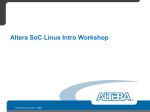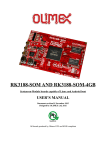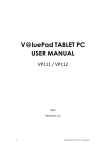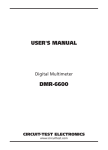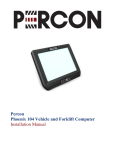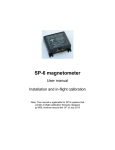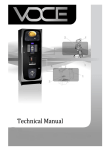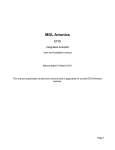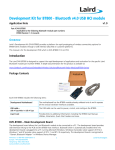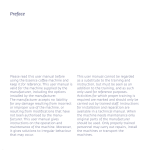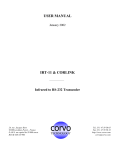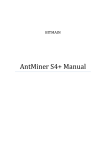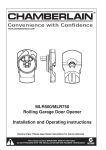Download Servo user and installation manual
Transcript
MGL Avionics Autopilot Servo Specifications & Installation Manual Last Update: 20 October 2010 Disclaimer: MGL Avionics should not be held responsible for errors or omissions in this document. Usage of all or part of this document for purposes unrelated to any product of MGL Avionics is prohibited under international copyright laws. October 2010 Servo Specifications & Installation Manual Page 1 of 12 Table of Content Introduction.............................................................................................................3 Servo Features........................................................................................................3 Communications Interfaces....................................................................................3 RS232 Interface..................................................................................................4 CAN Interface......................................................................................................4 Diagnostic LED....................................................................................................6 Force Measurement ...............................................................................................6 Electrical Specifications and Setup.........................................................................6 Power Supply......................................................................................................6 9 Pin Connector Description...............................................................................7 Torque Settings...................................................................................................7 Step Speed..........................................................................................................8 Mechanical Specification........................................................................................8 Mechanical Drawings..........................................................................................8 Connecting Rod.................................................................................................10 Sheer Safety Screw...........................................................................................11 Packing List...........................................................................................................12 Standard Servo Kit............................................................................................12 Connecting rod kit.............................................................................................12 October 2010 Servo Specifications & Installation Manual Page 2 of 12 Introduction Introduction The MGL Avionics EFIS units (Enigma, Voyager and Odyssey) all contain an integrated autopilot command system (the “heart” of the autopilot). The only additional hardware required to provide full autopilot functionality in a MGL EFIS equipped aircraft is a set of MGL Avionics Servo's - serving as the actuators to manipulate the elevator, ailerons, etc. This document outlines the functional specifications and installation instructions of the servo. The document is aimed at experienced aircraft builders that are capable of accepting full responsibility for the installation of the servos. The servo installation should not be performed by some that is not familiar with the potential dangers of incorrect installation (for example “over center lock-up”). Three different versions of the servo are available: – low torque (2.8Nm) – medium (standard) torque (4.8Nm) – high torque (6.3Nm). The low and high torque servos are only manufactured on special request. Servo Features The MGL Avionics Servo feature include: – Precision machined and anodized solid Aluminum housing – Output shaft runs inside double bearings – 12 bit output shaft position measurement (sub 0.1 degree resolution) – Zero contact magnetic output shaft position measurement (no “pots”) – Force measurement (no additional external subsystems required) – Low residual torque – Automatic slip detection – Digitally adjustable maxim torque setting (4.8Nm – standard servo) – Robust sub D9 connector simplifying inspection and modular installation – CAN and RS232 interfaces – Wide input voltage range (8V – 30V) – Output arm equipped with safety sheer screw – 4 + 4 mounting holes to simplify installation (4 side mounting holes) – 8 holes to fit travel limiting bolts/plate (preventing “over center” lock-up) – Diagnostic LED indicating communication mode and errors conditions – 360 degree freedom of movement to simplify installation and setup Communications Interfaces Command and feedback messages can be transmitted to and received from the servo using one of two protocols: CAN (Controller Area Network) or RS232. Note: Do not try and use both the CAN and RS232 communications interfaces simultaneously. This will cause conflict and the servo will try and follow both sets of commands! October 2010 Servo Specifications & Installation Manual Page 3 of 12 Communications Interfaces Enigma EFIS's are not equipped with an internal CAN port and an the internal RS232 port or a Communications Extender (COEX) is required to connect to the servo(s). The Voyager and Odyssey units contain an internal CAN interface. Only the internal CAN bus can be used to drive the servos. For more information on setting up the autopilot and communications interfaces on the EFIS, see the “ Integrated Autopilot User and Installation Manual” available from http://www.mglavionics.co.za/Docs/Autopilot.pdf. RS232 Interface The RS232 communications driver hardware inside the servo allows for multiple servos to be connected to a single RS232 port. The host (EFIS or PC) will transmit a single command message to all of the connected servos. A fixed response delay time is assigned to each servo (depending on the servo function pitch, bank, yaw, etc). It is recommended that a 33 ohm resistor is fitted in the signal ground return line to prevent large currents from flowing from the servo to the COEX or the internal RS232 port. Only one 33 ohm resistor is required - even if multiple servos are connected to the same RS232 port (see figure 1 below). The servo RS232 interface is not only used to command the servo, but also to program the unit and perform diagnostic functions. The servo firmware can be upgraded using the RS232 interface. The MGL Avionics servo RS232 communications protocol is open to be general public and 3rd parties are invited to make use of the servo. For more information on the RS232 communications protocols refer to the “MGL Avionics Servo RS232 Protocol” document. CAN Interface The CAN bus is a differential signal bus that runs at 250kbps and requires no ground reference. A number of nodes can be hooked onto a single CAN bus. Two terminating resistors of 120 ohms should be installed on the CAN bus. If we assume that no other equipment (engine monitors, AHRS units, etc) are connected to the CAN bus, fit the two 120 ohm resistors as follow: – the first resistor is installed close to the EFIS, while... – the second terminating resistor is installed close to the servo with the longest communications / wire path to the EFIS. See figure 2 for details on wiring the servo CAN interface. Servo number “X” is assumed to be located at the furtherest point from the EFIS. October 2010 Servo Specifications & Installation Manual Page 4 of 12 Communications Interfaces Note: Female DB9 Connectors seen from Outside Figure 1: Wiring the RS232 interface for a set of servos Note: Female DB9 Connectors seen from Outside Figure 2: Wiring the CAN interface for a set of servos October 2010 Servo Specifications & Installation Manual Page 5 of 12 Communications Interfaces As is the case with the RS232 protocol, the MGL Avionics servo CAN communications protocol is open to the general public and 3 rd parties are invited to make use of the servo (at own risk). For more information on the CAN communications protocols refer to the “MGL Avionics Servo CAN Protocol” document. Diagnostic LED A single red LED is visible next to the 9 pin connector. This LED is used to communicate the following information: – No power connected, or LED failed (LED off) – Power on but no data/commands being received (solid on, no flashing) – Power on and RS232 commands being received (slow flashing, 0.5 Hz) – Power on and CAN commands being received (fast flashing, 2 Hz) – Power on but error detected (erratic flashing, “short-short-long”) During power up the unit performs built in testing (BIT) and if any errors are found (for example a single byte of code is invalid) the unit will not engage / respond to any communication, but rather signal this error message using an erratic LED flashing pattern. Force Measurement The MGL servo transmits a number that provides an indication of the load on the servo output shaft. This number is not an absolute or accurately linear measurement of force or torque. It is however useful as a low frequency feedback signal to be used to adjust the trim of the aircraft. It provides a good indication of direction of the load (up or down, left or right) and size of the load (small, medium, large, very large). The numbers range between -60 and +60. The force is only measured during the “hold” phase of operation (once the output arm has reached the target position; not while the servo arm is stepping / moving). If a torque setting of (approximately) 85% or more is selected, the force measurement will not be activated. The force measurement can be felt as a slight vibration on the aircraft controls. Electrical Specifications and Setup Power Supply An input supply voltage of 12V – 15V is recommend. The servo will however run off 10V – 30V. Do not exceed 34V. The standard servo draws an average of 0.9A at 13.8V to deliver the maximum holding torque of 4.8Nm. The maximum stepping torque of 4.8Nm is obtained drawing an average of 1.71A at 13.8V. The servos have been installed successfully without the addition of external capacitors, but depending on the length and thickness of the wires used to supply the current to the servo, it might be a good idea to fit a large electrolytic October 2010 Servo Specifications & Installation Manual Page 6 of 12 Electrical Specifications and Setup capacitor close to each servo. (2200uF and 10 000uF 35V electrolytic capacitors are available from your local MGL Avionics distributors.) In order to accommodate the current required, 18 to 20 gauge wires should be used for the power wires (positive and negative supply). Thinner wires can be used for the signal wires. If the servo is installed onto an bracket that is grounded (for example in an all metal aircraft), ensure that the area created by the returning ground (thick) power cable is kept to a minimum – keep the distance between the wire and the metal construction to a minimum for the full length of the cable up to termination into the power bus. 9 Pin Connector Description A single SubD9 cannon connector is used to connect all power and data lines to the servo. Use a Pin Number Function/Description 1 Battery Minus / Ground (GND) 2 No Connection (NC) 3 RX RS232 4 TX RS232 5 No Connection (NC) 6,7 Battery Positive / +12 to +28V 8 CAN Low 9 CAN High Cannon D-9 connector pin description for the Servo The pin numbers 1, 5, 6 and 9 are written in small print on the connector. Note that the casing is hard connected to ground as well. Pin 1 is wired directly onto the casing and the ground planes of the internal electronics. The casing also serves as a heat sink for the power electronics. Torque Settings The true output torque (stepping and holding) and whether force measurement is being performed vs torque percentage setting for the standard servo is given below (measured at 13.8V supply, room temperature): Torque Setting Torque Setting [-] [%] 0 0 1 7 2 13 3 20 4 27 October 2010 Torque Step/Hold [Nm] 4.8 / 2.4 4.8 / 2.4 4.8 / 3.0 4.8 / 3.0 4.8 / 3.7 Current Step/Hold [A] 1.71 / 0.25 1.71 / 0.25 1.71 / 0.32 1.71 / 0.32 1.71 / 0.46 Servo Specifications & Installation Manual Force Measured? Yes Yes Yes Yes Yes Page 7 of 12 Electrical Specifications and Setup 5 6 7 8 9 10 11 12 13 14 15 33 40 47 53 60 67 73 80 87 93 100 4.8 / 3.7 4.8 / 3.9 4.8 / 3.9 4.8 / 4.1 4.8 / 4.1 4.8 / 4.3 4.8 / 4.3 4.8 / 4.5 4.8 / 4.7 4.8 / 4.8 4.8 / 5.5 1.71 / 0.46 1.71 / 0.52 1.71 / 0.52 1.71 / 0.58 1.71 / 0.58 1.71 / 0.60 1.71 / 0.60 1.71 / 0.66 1.71 / 0.71 1.71 / 0.84 1.60 / 0.98 Yes Yes Yes Yes Yes Yes Yes Yes No No No The residual torque of the standard servo is approximately 0.28Nm. Step Speed The slew rate (step speed) of the standard servo is set to 35 degrees per second (speed setting 20). For special applications the slew rate can be increased or decreased using special PC software. Slew rates of 100 degrees per second (step speed setting 7) can be obtained, but at the cost of reduced maximum torque (unless a different stepper motor is fitted). Contact your local MGL Avionics distributor if you have an application that requires adjustments to the step speed or stepper motor type. Mechanical Specification Mechanical Drawings All dimensions are provided in millimeters (mm) unless stated otherwise. All bolts are metric and supplied as part of the servo kit. The industry standard 4 mounting holes are provided on the top face of the servo (figure 3). In addition 4 more (2 on each side) holes are provided to be utilized in alternative mounting configurations (figure 5). Four 10mm x M5 and four 20mm x M5 bolts are provided in the servo kit. To prevent damage to the system and the dangerous “over center” lock-up situation, eight M4 threaded holes are provided to mount a plate or bolts to limit the maximum travel (figure 4). Two M4 hardened steel bolts are provided with each servo. Standard servo weight: 1.38kg October 2010 Servo Specifications & Installation Manual Page 8 of 12 Mechanical Specification Figure 3: Top View Figure 4: Limiting Travel (section A taken from Top View) October 2010 Servo Specifications & Installation Manual Page 9 of 12 Mechanical Specification Figure 5: Servo Side View Connecting Rod As an additional optional extra an installation kit can be ordered from your local MGL Avionics distributor. One standard metric installation kit contains the necessary parts to connect one servo to one actuator. Figure 6: Connecting Rod The Rod End Pieces have been designed to be compatible with imperial standard tubes. If longer lengths of tube are required, the supplied tube can be replaced with a longer length of 0.5” outside diameter (0.402” ID) 6061 T6 Aluminum obtainable from companies like Aircraft Spruce. October 2010 Servo Specifications & Installation Manual Page 10 of 12 Mechanical Specification Sheer Safety Screw A mild steel screw is just to prevent the output arm from rotating relative to the output shaft. The screw has been selected to fail gracefully when 12Nm of torque is applied to the output arm. Do not replace the screw with another type of screw. Output Arm kept from rotating relative to Output Shaft and Collar due to Sheer Screw (in place) October 2010 Output Shaft and Collar with Output Arm removed exposing 4 sets of thread for the Sheer Screw Servo Specifications & Installation Manual Page 11 of 12 Packing List Packing List Standard Servo Kit Contained in every standard servo kit you will find the following components: – – – – – – – – – 1 x Servo 1 x Installation Manual 4 x 10mm x M5 Bolts (RH thread) 4 x 20mm x M5 Bolts (RH thread) 2 x 25mm x M4 Bolts (hardened steel) 2 x 120 ohm 0.25W resistor (band colors: brown, red, brown) 1 x 33 ohm 0.25W resistor (band colors: orange, orange, black) 1 x Nylon Shell (for sub D9 connector) 1 x Sub D9 Male Solder Bucket Connector Connecting rod kit The standard metric optional extra installation kit contains the following: – – – – – 1 x 300mm x 10.3mm ID / 12.7mm OD 6063 Aluminum Tube 2 x M5 Rose Joint / End Bolt Bearing (1 x LH & 1 x RH thread) 2 x M5 Female Rod End Piece (1 x LH & 1 x RH thread) 2 x M5 Nuts (1 x LH & 1 x RH thread) 4 x Aluminum Rivets October 2010 Servo Specifications & Installation Manual Page 12 of 12












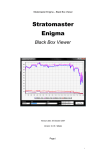




![sf-list [s]](http://vs1.manualzilla.com/store/data/005727021_1-5e70d84b679a2d9887789b982f459474-150x150.png)
